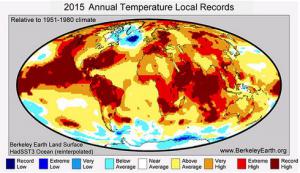Emerging threats2015 surpassed 2014 as the warmest year since at least the mid-to-late nineteenth century
A new State of the Climate report confirmed that 2015 surpassed 2014 as the warmest year since at least the mid-to-late nineteenth century. Last year’s record heat resulted from the combined influence of long-term global warming and one of the strongest El Niño events the globe has experienced since at least 1950. The report found that most indicators of climate change continued to reflect trends consistent with a warming planet. Several markers such as land and ocean temperatures, sea levels, and greenhouse gases broke records set just one year prior.

2015 local temperature records // Source: commons.wikimedia.org
A new State of the Climate report confirmed that 2015 surpassed 2014 as the warmest year since at least the mid-to-late nineteenth century.
Last year’s record heat resulted from the combined influence of long-term global warming and one of the strongest El Niño events the globe has experienced since at least 1950. The report found that most indicators of climate change continued to reflect trends consistent with a warming planet. Several markers such as land and ocean temperatures, sea levels, and greenhouse gases broke records set just one year prior.
These key findings and others are available from the State of the Climate in 2015 report released online by the American Meteorological Society (AMS).
NOAA says that the report, led by NOAA National Centers for Environmental Information, is based on contributions from more than 450 scientists from sixty-two countries around the world and reflects tens of thousands of measurements from multiple independent datasets (highlights, visuals, full report)). It provides a detailed update on global climate indicators, notable weather events, and other data collected by environmental monitoring stations and instruments located on land, water, ice, and in space.
“This ‘annual physical’ of Earth’s climate system showed us that 2015’s climate was shaped both by long-term change and an El Niño event,” said Thomas R. Karl, director of NOAA National Centers for Environmental Information. “When we think about being climate resilient, both of these time scales are important to consider. Last year’s El Niño was a clear reminder of how short-term events can amplify the relative influence and impacts stemming from longer-term global warming trends.”
The report’s climate indicators show patterns, changes, and trends of the global climate system. Examples of the indicators include various types of greenhouse gases; temperatures throughout the atmosphere, ocean, and land; cloud cover; sea level; ocean salinity; sea ice extent; and snow cover.
